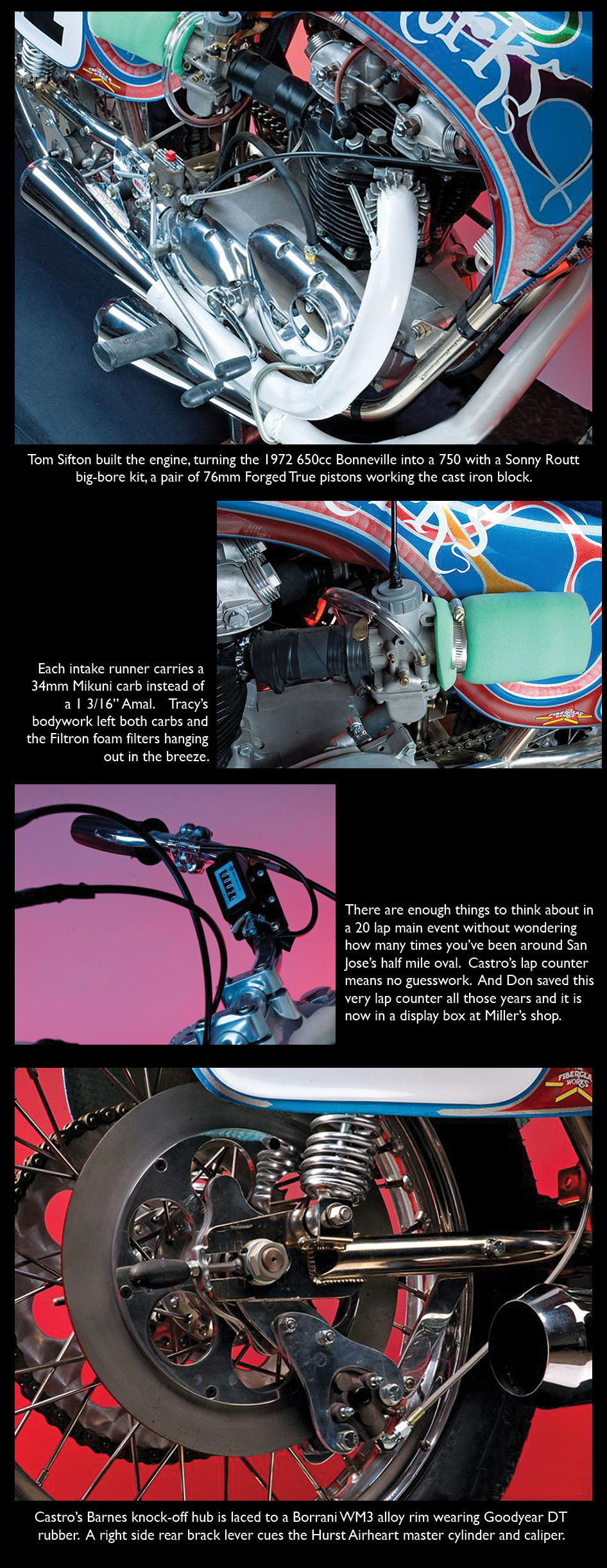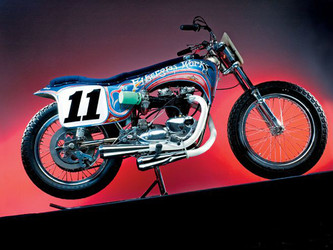Don Castro's Outlaw Justice - Part Two
Posted by Norm DeWitt, Motorcyclist Magazine - Photo credit: Jeff Hackett on Aug 8th 2018
The Don Castro Red-lined framed, Tracy Fiberglas Triumph only raced once, pronounced illegal for slipstreaming by the AMA and then retired in 1972. The bike could have disappeared after that. And without Don Miller, it probably would have. Miller has been a flat track fanatic for as long as he can remember. After hitching a ride to the races with his older brothers to watch another Don (Castro) win one for Team Yamaha, Miller got a shiny new one of his own. He was a Don Castro fan for life.
Fast-forward to the mid-'90s, when Miller meets Castro while writing a story for Old Bike Journal. Castro needs a ride for a vintage race in New York, so Miller rolls out a cool Yamah. "The year before at the same race Dave Aldana rode my Yamaha and blew it up," says Miller. "I didn't care. I got a bigger and better motor for Don Castro. After the weekend we became good friends. After that, I got Don to part with some of his old racing stuff: a set of his Yamaha leathers and a Bell helmet. He asked if I wanted that old Tracy body. We made a deal and I got the start of this bike. After being banned back in '72, the bodywork was useless for racing, so Castro lent it to a friend who painted it all one color and used it on a street Triumph. Before selling the bike, he returned it to Don. One of the coolest racing bodies lay up in Don's attic for years, never to be seen again if I hadn't been pestering him. I compiled a bunch of other parts over the years, but Don didn't know where the rest of the Triumph ended up, so I searched for leads."
Then, in '97, Miller's phone rang. "I just talked to Don Castro," said the guy on the other end. "I have what's left of his Red Line-framed Triumph." Miller's heart just about stopped. The guy's Dad had the bike. He rode it in some local races, and then parked it. He'd sold the blown up engine years ago, but aside from a smashed downtime, the frame and swingarm were intact. "I asked Don if he was interested in buying it," the guy told Miller. "He said no, but that I should call you." After checking to make sure he was still breathing, Miller got a price and promised to call back later that day. "I had to check out his story, so I called Don and everything was legit." Another piece of the puzzle was in Miller's hands.
Putting all those pieces back together the way they were in the summer of '72 was tough. Renowned dirt track photographer Dan Mahony sent every image he had of the bike, but there weren't many. Mahony remembered the day: It was overcast; not enough sun to shoot color, so everything he had was in black and white. Texas flat track historian Bill Milburn authenticated a lot of parts that were on the original bike and found others, including the Carl's Sport Center primary cover. "It took him almost a year to track that one down and a while longer to talk the owner into selling it," Miller says. "I traded a nice Harley Sprint hardtail racing frame for it. Don was also a big help. I would send him pictures as the restoration progressed and he gave me advise along the way."
Looking as outrageous as it did rolling out of Tracy's Santa Cruz shop nearly four decades earlier, the Triumph is current on display at Miller's Metro Racing headquarters in Brackney, Pennsylvania. "We take it to shows from time to time. I even took it to the Grand National race at Monticello, New York. It was cool to see the new breed of racers stop and have a look at what they would have been riding back in '72," Miller says. "It's a motorcycle that might have changed everything about the sport. And the longer you stand and look, the more you wonder what flat track might look like today if it had."


